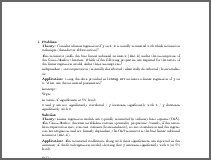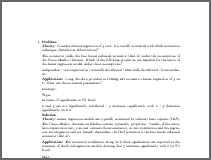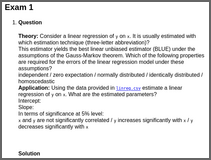lm2: Simple Linear Regression (Cloze with Theory and Application)
lm2Theory: Consider a linear regression of y on x. It is usually estimated with which estimation technique (three-letter abbreviation)?
This estimator yields the best linear unbiased estimator (BLUE) under the assumptions of the Gauss-Markov theorem. Which of the following properties are required for the errors of the linear regression model under these assumptions?
Application: Using the data provided in linreg.csv estimate a linear regression of y on x. What are the estimated parameters?
Intercept:
Slope:
In terms of significance at 5% level:
Theory: Linear regression models are typically estimated by ordinary least squares (OLS). The Gauss-Markov theorem establishes certain optimality properties: Namely, if the errors have expectation zero, constant variance (homoscedastic), no autocorrelation and the regressors are exogenous and not linearly dependent, the OLS estimator is the best linear unbiased estimator (BLUE).
Application: The estimated coefficients along with their significances are reported in the summary of the fitted regression model, showing that y increases significantly with x (at 5% level).
Call:
lm(formula = y ~ x, data = d)
Residuals:
Min 1Q Median 3Q Max
-0.50503 -0.17149 -0.01047 0.13726 0.69840
Coefficients:
Estimate Std. Error t value Pr(>|t|)
(Intercept) -0.005094 0.023993 -0.212 0.832
x 0.558063 0.044927 12.421 <2e-16
Residual standard error: 0.2399 on 98 degrees of freedom
Multiple R-squared: 0.6116, Adjusted R-squared: 0.6076
F-statistic: 154.3 on 1 and 98 DF, p-value: < 2.2e-16Code: The analysis can be replicated in R using the following code.
## data
d <- read.csv("linreg.csv")
## regression
m <- lm(y ~ x, data = d)
summary(m)
## visualization
plot(y ~ x, data = d)
abline(m)Theory: Consider a linear regression of y on x. It is usually estimated with which estimation technique (three-letter abbreviation)?
This estimator yields the best linear unbiased estimator (BLUE) under the assumptions of the Gauss-Markov theorem. Which of the following properties are required for the errors of the linear regression model under these assumptions?
Application: Using the data provided in linreg.csv estimate a linear regression of y on x. What are the estimated parameters?
Intercept:
Slope:
In terms of significance at 5% level:
Theory: Linear regression models are typically estimated by ordinary least squares (OLS). The Gauss-Markov theorem establishes certain optimality properties: Namely, if the errors have expectation zero, constant variance (homoscedastic), no autocorrelation and the regressors are exogenous and not linearly dependent, the OLS estimator is the best linear unbiased estimator (BLUE).
Application: The estimated coefficients along with their significances are reported in the summary of the fitted regression model, showing that y decreases significantly with x (at 5% level).
Call:
lm(formula = y ~ x, data = d)
Residuals:
Min 1Q Median 3Q Max
-0.48304 -0.14595 -0.00285 0.14840 0.61220
Coefficients:
Estimate Std. Error t value Pr(>|t|)
(Intercept) 0.01095 0.02348 0.466 0.642
x -0.69632 0.04031 -17.272 <2e-16
Residual standard error: 0.233 on 98 degrees of freedom
Multiple R-squared: 0.7527, Adjusted R-squared: 0.7502
F-statistic: 298.3 on 1 and 98 DF, p-value: < 2.2e-16Code: The analysis can be replicated in R using the following code.
## data
d <- read.csv("linreg.csv")
## regression
m <- lm(y ~ x, data = d)
summary(m)
## visualization
plot(y ~ x, data = d)
abline(m)Theory: Consider a linear regression of y on x. It is usually estimated with which estimation technique (three-letter abbreviation)?
This estimator yields the best linear unbiased estimator (BLUE) under the assumptions of the Gauss-Markov theorem. Which of the following properties are required for the errors of the linear regression model under these assumptions?
Application: Using the data provided in linreg.csv estimate a linear regression of y on x. What are the estimated parameters?
Intercept:
Slope:
In terms of significance at 5% level:
Theory: Linear regression models are typically estimated by ordinary least squares (OLS). The Gauss-Markov theorem establishes certain optimality properties: Namely, if the errors have expectation zero, constant variance (homoscedastic), no autocorrelation and the regressors are exogenous and not linearly dependent, the OLS estimator is the best linear unbiased estimator (BLUE).
Application: The estimated coefficients along with their significances are reported in the summary of the fitted regression model, showing that x and y are not significantly correlated (at 5% level).
Call:
lm(formula = y ~ x, data = d)
Residuals:
Min 1Q Median 3Q Max
-0.60164 -0.14469 0.00875 0.13215 0.52337
Coefficients:
Estimate Std. Error t value Pr(>|t|)
(Intercept) -0.004520 0.023506 -0.192 0.848
x -0.001162 0.039513 -0.029 0.977
Residual standard error: 0.2326 on 98 degrees of freedom
Multiple R-squared: 8.82e-06, Adjusted R-squared: -0.0102
F-statistic: 0.0008643 on 1 and 98 DF, p-value: 0.9766Code: The analysis can be replicated in R using the following code.
## data
d <- read.csv("linreg.csv")
## regression
m <- lm(y ~ x, data = d)
summary(m)
## visualization
plot(y ~ x, data = d)
abline(m)Demo code:
library("exams")
set.seed(403)
exams2html("lm2.Rmd")
set.seed(403)
exams2pdf("lm2.Rmd")
set.seed(403)
exams2html("lm2.Rnw")
set.seed(403)
exams2pdf("lm2.Rnw")


